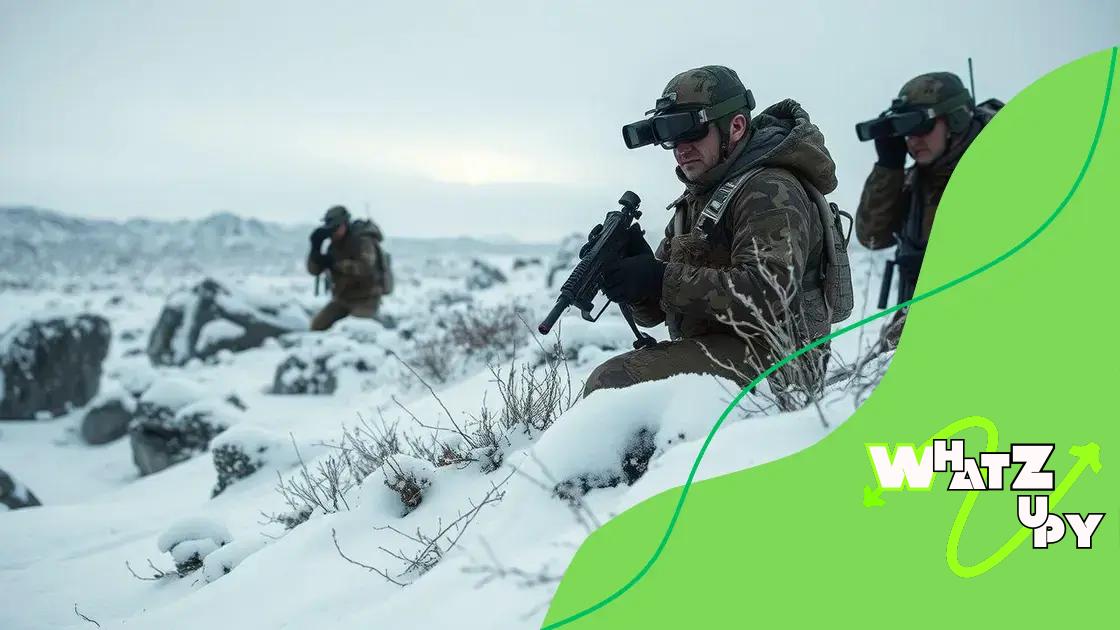US spy agencies Greenland surveillance: uncovering secrets

US spy agencies employ advanced surveillance technologies in Greenland to gather intelligence, impacting national security while raising significant privacy concerns among citizens.
US spy agencies Greenland surveillance has become a topic of heated debate. What could this mean for privacy and global relations? Let’s delve into these complex layers.
Overview of US spy agencies
The overview of US spy agencies reveals a complex system designed to safeguard national security. These agencies work together to gather intelligence and counter threats. Understanding their roles helps demystify their activities.
Key US intelligence organizations
Several major organizations lead the intelligence community. Each agency specializes in different aspects of intelligence gathering.
- The Central Intelligence Agency (CIA) focuses on foreign intelligence.
- The National Security Agency (NSA) excels in signals intelligence and cybersecurity.
- The Federal Bureau of Investigation (FBI) handles domestic intelligence and counterterrorism.
These agencies often collaborate, sharing important information to optimize their operations. The structures are built to adapt to the evolving nature of global threats.
Mission and objectives
The core mission of US spy agencies includes:
- Identifying and neutralizing threats.
- Gathering information to inform policy decisions.
- Supporting military operations.
Each agency has distinct objectives but shares the common goal of enhancing the security of the United States. The agencies rely on both human intelligence and advanced technology to execute their missions effectively.
The collaboration between agencies ensures a comprehensive approach to national safety. With modern challenges, these organizations have had to evolve constantly, utilizing new technologies and strategies.
Historical context of surveillance in Greenland
The historical context of surveillance in Greenland reveals a rich tapestry of international relations and strategic interests. This remote location has been of significant interest to various countries throughout history due to its geographic position.
Initially, Greenland served as a strategic military base during World War II. The U.S. and Britain established a presence on the island to control the North Atlantic. This marked the beginning of heightened surveillance activities.
Cold War Era
During the Cold War, Greenland’s importance grew as the U.S. sought to monitor Soviet activities. The establishment of Thule Air Base in 1951 became a pivotal point for espionage and reconnaissance missions. The base still plays a crucial role in modern surveillance.
- Thule Air Base allows for early missile warning systems.
- Intelligence collection focuses on Arctic operations.
- Its location is strategic for tracking polar routes.
As technology advanced, so did the methods of surveillance. The use of satellites became essential, enabling comprehensive monitoring of both military and environmental changes.
The post-Cold War era introduced new challenges. Greenland’s terrain became critical for understanding climate change and its impacts. Surveillance shifted to include environmental monitoring alongside traditional security efforts.
Contemporary Developments
Today, surveillance in Greenland reflects a blend of military, environmental, and scientific interests. The U.S. continues to prioritize intelligence gathering to ensure national security while addressing global concerns.
Furthermore, the Canadian and Danish governments also monitor activities in the region. This cooperation showcases the growing complexities of international intelligence.
The conversation around surveillance and privacy continues to evolve. As more nations express interest in Greenland, the implications of increased surveillance will unfold in the coming years.
The technology behind espionage

The technology behind espionage plays a crucial role in modern intelligence operations. As the world evolves, so do the tools and techniques used for gathering information. These advancements help intelligence agencies stay a step ahead of potential threats.
One major area of focus is cyber espionage. This involves using digital techniques to infiltrate systems and extract sensitive data. Highly skilled hackers are often the backbone of these efforts. They utilize various methods, including:
Common cyber espionage methods
- Phishing attacks to deceive individuals into revealing information.
- Malware to gain unauthorized access to networks.
- Exploiting vulnerabilities in software and hardware.
Along with cyber strategies, traditional espionage methods remain vital. Agencies still rely on the human element, employing operatives to gather intel in person. These operatives utilize advanced devices such as miniaturized cameras and microphones to relay information discreetly.
Surveillance technologies
Surveillance technology has also advanced considerably. Drones now play a significant role in collecting visual intelligence. Equipped with high-resolution cameras, they can monitor vast areas without being detected. Additionally, satellite imagery provides broad coverage and detailed views of locations worldwide.
Another technology of note is signal intelligence (SIGINT). This involves collecting and analyzing electronic signals, including phone calls, texts, and emails. Agencies use sophisticated software to intercept and decode these communications, revealing crucial insights.
As these technologies continue to develop, the future of espionage looks increasingly complex. Methods once confined to fiction are becoming reality, raising both security and ethical questions.
Implications for international relations
The implications for international relations due to surveillance activities are profound and far-reaching. The monitoring of nations, especially by powerful agencies, can foster distrust and tension among countries.
Surveillance can lead to accusations of infringement on sovereignty. When one nation suspects that another is spying, it can result in diplomatic disputes. These tensions often manifest in various forms, from public statements to sanctions.
Trust and cooperation
Moreover, the balance of trust heavily affects international cooperation. Countries that openly share intelligence can foster stronger alliances. Conversely, those that engage in secretive surveillance risk damaging their relationships.
- Intelligence sharing among allies strengthens security.
- Surveillance can discourage collaboration on critical issues like terrorism and climate change.
- Public knowledge of surveillance can lead to protests and demands for transparency.
As more nations enhance their surveillance capabilities, the landscape of international relations becomes more complex. Countries feel compelled to match each other’s capabilities, leading to an arms race in technology and intelligence.
The rise of non-state actors also plays a role. Groups can disrupt traditional dynamics by exploiting surveillance weaknesses, creating new challenges for national security. This reality prompts countries to reconsider their strategies to ensure their interests are protected.
The future of diplomacy
Looking ahead, the future of diplomacy will likely involve greater scrutiny of surveillance practices. Nations may need to establish clearer agreements on acceptable practices. This change could foster a safer global environment.
Ultimately, the implications of surveillance on international relations are significant. Addressing these issues will require diplomatic finesse, strong leadership, and an understanding of the evolving global landscape.
Public reaction and privacy concerns
The public reaction and privacy concerns surrounding surveillance activities have gained significant attention in recent years. As nations expand their monitoring capabilities, citizens are becoming increasingly aware of their rights and the implications of surveillance.
Many people feel uneasy about the extent of government monitoring. This concern is heightened by revelations from whistleblowers and leaks, which often expose previously hidden surveillance practices. For instance, programs that collect large amounts of personal data without consent have sparked outrage.
Key concerns among the public
Several major concerns frequently arise in discussions about surveillance:
- Invasion of privacy: Citizens worry that their private lives are under constant scrutiny.
- Lack of transparency: Many demand more information about how data is collected and used.
- Potential for abuse: There are fears that surveillance tools could be used to target specific groups or individuals.
These issues fuel a growing movement advocating for privacy rights. People increasingly call for regulations to protect their information. Grassroots organizations are mobilizing to raise awareness and hold governments accountable.
Legislative Responses
In response to public pressure, some governments are considering or implementing stricter regulations on surveillance. They are beginning to recognize the need to balance national security with citizens’ rights. Proposals for legislation include:
- Establishing clearer rules on data collection.
- Implementing oversight mechanisms to prevent abuse.
- Enhancing public access to information regarding surveillance practices.
The dialogue between the public and the government continues to evolve. As technology progresses, the demands for privacy protection will likely intensify. Understanding and addressing these concerns is essential for maintaining trust in government institutions.
FAQ – Questions about US Spy Agencies and Surveillance in Greenland
What are the primary roles of US spy agencies?
US spy agencies primarily gather intelligence to protect national security, monitor threats, and support military operations.
How does surveillance impact privacy rights?
Surveillance raises significant privacy concerns, as citizens may feel their personal lives are being monitored without consent.
What technologies are used in modern espionage?
Modern espionage utilizes cyber tools, satellite imagery, and human intelligence to gather information effectively.
How can the public influence surveillance practices?
The public can influence surveillance practices by advocating for privacy rights, demanding transparency, and supporting legislation that protects individual freedoms.





